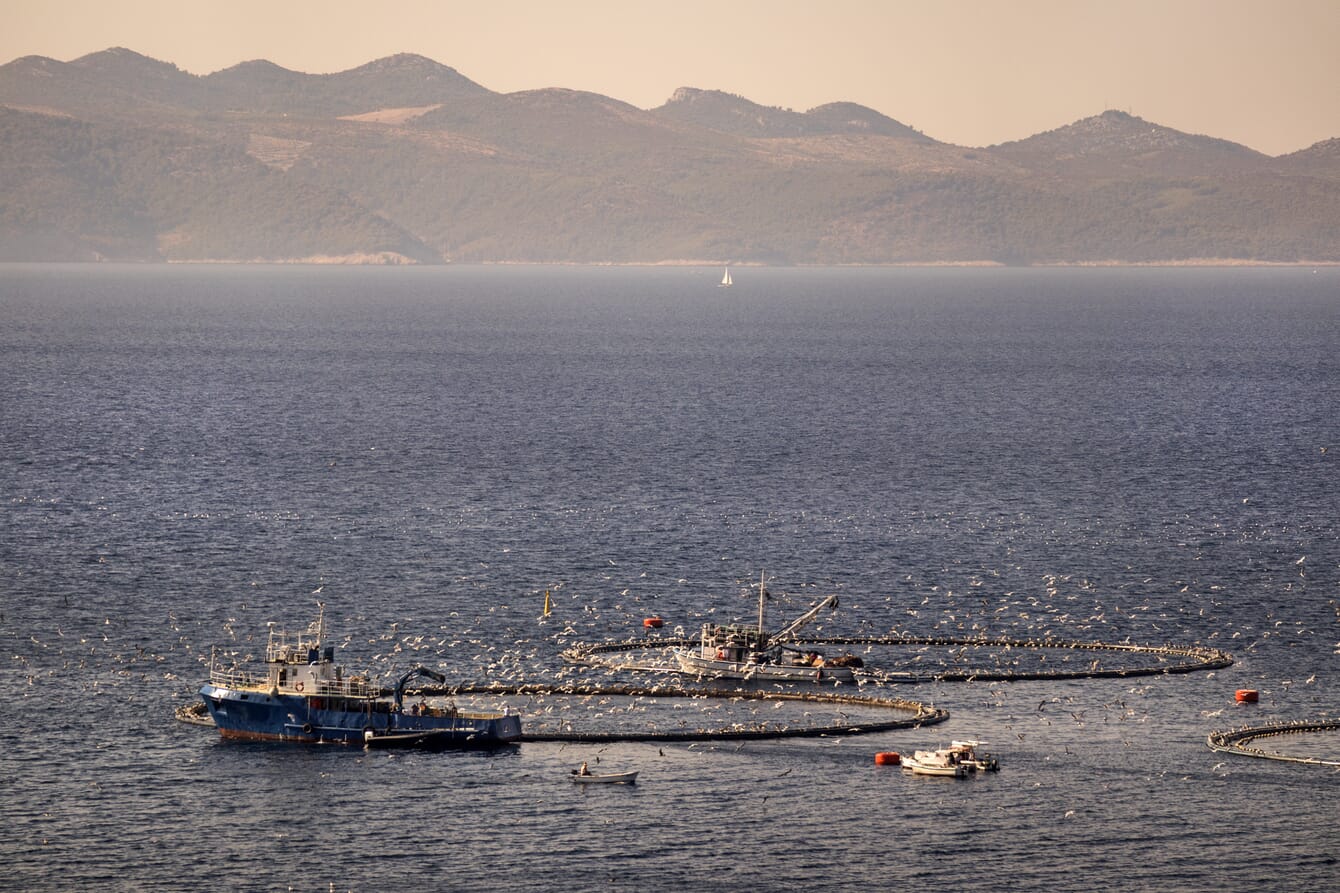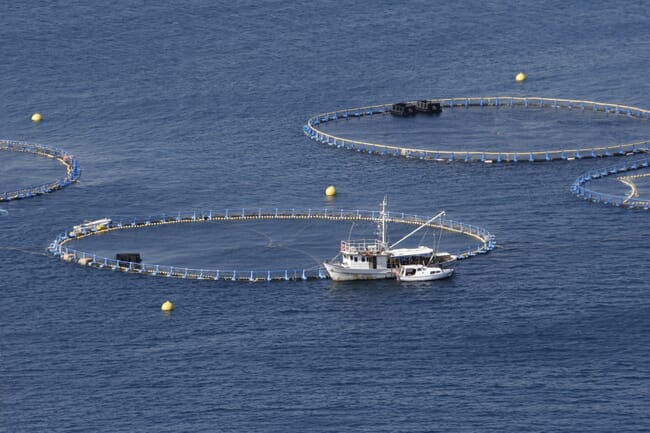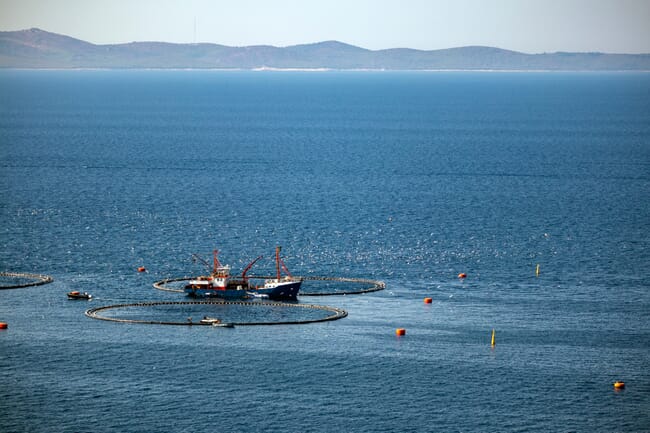
A major drawback with bluefin tuna farming is the high feed conversion ratio, with an average of 15-20 kg of feed needed to produce one kilogram of tuna © Shutterstock
Background
Growing demand for bluefin tuna in the 1980s, notably from the Japanese sushi-sashimi market, made the Mediterranean tuna fishery highly profitable. However, as the price and demand for tuna increased, illegal, unreported and unregulated (IUU) fishing practices became more prevalent, contributing to a decline in tuna stocks. To safeguard the conservation of tuna and related species, the International Commission for the Conservation of Atlantic Tunas (ICCAT) established compulsory management measures – including quotas, the introduction of minimum landing sizes, and time-area closures.
This led to increased efforts to either ranch – ie on-grow wild-caught tuna in captivity – or farm tuna, with Croatian companies and researchers active in both. And these sectors generate an annual export value of between $70 and $80 million for the country and create valuable job opportunities in its coastal communities.
To farm or to ranch?
Farmers at Kali Tuna in Ugljan achieved an enormous breakthrough in 2009, by successfully breeding tuna from eggs - making them only the second country in the world, after Japan, to do so successfully. Since then the company’s tuna farming practices have received global recognition, including Friend of the Sea certification and the Superior Taste Award from the International Taste Institute.

Tuna ranching and farming in Croatia generates an annual export value of between $70 and $80 million and creates valuable job opportunities for the country's coastal communities © Shutterstock
However, despite this success, the industry still mainly relies on wild-caught fish and 12 Croatian fishermen are permitted to use rods and lines to catch bluefin tuna weighing a minimum of 8 kg for on-growing. This is slightly lower than the 10 kg threshold that applies elsewhere, as the International Commission for the Protection of Atlantic Tunas (ICCAT) conceded that the Adriatic is a natural feeding ground for younger specimens.
These are then transported to the farm via wellboats or in towed transport cages and, once they are grown to 30 kg – usually after 2.5 years – they can be sold on the market. In line with other countries that farm tuna, Croatia must follow a rigorous set of regulations and guidelines throughout the entire process - from catching the fish to selling it.
The transfer to the farm is recorded using special equipment and software to read the number of specimens in the cage and their weight. The process is subject to stringent international oversights, with each tuna assigned a unique passport.
The farming process
Tuna are sizeable fish that require constant swimming and have a high oxygen demand. Hence, it is crucial to raise them in sturdy, spacious cages located in exposed oligotrophic coastal waters at least 50 m deep. These areas must have currents greater than 10 cm/s, a salinity range of 36 to 39 parts per thousand (PPT), and dissolved oxygen levels exceeding 90 percent, as specified by the Croatian Regulation on Criteria for the Establishment of Marine Aquaculture Areas.

A 2019 report by the Croatian Ministry of Agriculture estimated the investment cost for offshore tuna farming in Croatia is approximately €3.3 million © Shutterstock
The breeding cycle begins with transferring mature fish to circular breeding cages with a diameter of 50 to 60 m and a depth of about 25 m. Typically, the breeding period lasts from July to December, but it can extend to February if necessary.
A tuna is usually fed between one and three times a day, and the amount of food depends on its size, the temperature of the sea, and its reaction to the food. The tuna are fed a special diet that includes fresh sardines and anchovies – the same fish that attract wild tuna to the Adriatic.
Challenges and limitations
While bluefin tuna farming has become a successful industry in Croatia, it still faces several challenges and limitations that must be addressed to ensure its long-term sustainability.
One of the major drawbacks of Croatian tuna farming is its heavy reliance on the Japanese market. However, this issue can be dealt with by exploring new market opportunities and diversifying the product range, such as catering to the tourism industry.
In addition, the cost of establishing a tuna farm makes it difficult for new farmers to enter the market. According to a 2019 report by the Croatian Ministry of Agriculture, the average investment cost for offshore tuna farming in Croatia is approximately €3.3 million. This cost includes the purchase of cages, mooring systems, feed systems, and other necessary equipment.
Bluefin tuna farming is still a relatively new industry and little is known about the long-term impacts of tuna farming on the environment and wild fish populations. There is a need for continued research and monitoring to ensure that tuna farming does not have a negative impact on the Adriatic ecosystem.
One major concern is the high feed conversion ratio, with an average of 15-20 kg of feed needed to produce one kilogram of tuna. This is significantly higher than many other farmed fish species, such as salmon which require under 1.5 kg of feed for every kg of growth, and tilapia or catfish, which have conversion rates closer to 1:1.
The restrictions imposed by the International Commission for the Conservation of Atlantic Tunas (ICCAT) are also challenging. Croatian negotiators worked hard to ensure that Croatian fishermen could catch smaller tuna for further cultivation, but continued monitoring and compliance with regulations are necessary to maintain sustainability.
Finally, the increasing cost of producing bluefin tuna is a significant concern for the industry. Farmers are under pressure to balance profitability with compliance to strict regulations. Following these guidelines can be expensive, which makes it challenging for the industry to keep prices affordable for consumers.
As a result, the industry is working hard to strike a delicate balance between profitability and sustainability.
"As the demand for this premium fish keeps increasing, its price has been consistently going up over the years," stated Mislav Bezmalinovic, CEO of Sardina, one of the leading Croatian tuna companies.
Fundamentally, maintaining a sustainable industry while also keeping prices reasonable will be crucial for long-term viability.
The future of tuna farming and ranching in Croatia
Currently it is still more profitable to catch tuna and then on-grow them, rather than to farm them from scratch and about 3,000 tonnes of tuna are harvested each year by operators who are on-growing the country’s 400 tonne quota of wild-caught tuna.
Meanwhile Croatia's tuna farming industry is experiencing an exciting period of growth and development. Cromaris, one of the leading tuna farming companies in Croatia, increased its production of farmed tuna by 10 percent in 2021 compared to the previous year. While there are challenges to be addressed, such as the high cost of establishing and maintaining a sustainable farming operation, the industry has demonstrated an impressive ability to recover from setbacks and adjust to changing circumstances.
Demand for bluefin tuna remains strong, and the industry is in a favourable position to meet it. However, transitioning from capture-based aquaculture to sustainable farming methods still requires significant investment in research and development.




